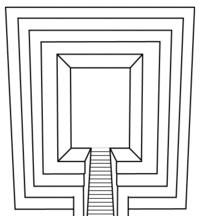Xin Zhui
| Xin Zhui | |
|---|---|
| Marquise of Dai | |
|
Artistic reconstruction of Xin Zhui. | |
| Dynasty | Han Dynasty |
| Husband | Li Cang (利蒼), Marquis of Dai |
| Born | ca. 213 BCE |
| Died | 163 BCE |
| Buried | Mawangdui, Changsha, Hunan Province, China |
Xin Zhui (Chinese: 辛追; pinyin: Xīn Zhuī; died 163 BCE), also known as Lady Dai or Marquise of Dai, was the wife of Li Cang (利蒼), the Marquis of Dai, during the Han Dynasty (206 BCE – 220 CE). She gained fame more than 2,000 years after her death, when her tomb was discovered inside a hill known as Mawangdui, in Changsha, Hunan, China. After opening the tomb, workers discovered her exceptionally preserved remains alongside hundreds of valuable artifacts and documents. Her body and belongings are currently under the care of the Hunan Provincial Museum, which has allowed occasional international exhibits.[1][2]
Life and death
Xin Zhui lived an extravagant lifestyle. She enjoyed having her own musicians for entertainment, whom she had play for parties as well as personal amusement.[3] She may have enjoyed playing music as well, particularly the qin, which was traditionally associated with refinement and intellect.[2][Note 1] As a noble, Xin Zhui also had access to a variety of imperial foods, including various types of meat, which were reserved for the royal family and members of the ruling class.[4] Much of her clothing was made of silk and other valuable textiles, and she owned a variety of cosmetics.[2][3]
As age caught up with her, Xin Zhui suffered from a number of ailments that would eventually lead to her death. Alongside a number of internal parasites, she also had coronary thrombosis and arteriosclerosis, most likely linked to excessive weight gained due to a sedentary lifestyle. A fused spinal disc probably caused her immense pain, which contributed to a decrease in physical activity. She also suffered from gallstones, one of which lodged in her bile duct and further deteriorated her condition.[5]
After outliving her husband and, potentially, her son, Xin Zhui died around 50 years of age in 163 BCE.[6][3] Her cause of death was a heart attack, brought about by years of poor health.[5] She was buried in an immense tomb at Mawangdui in Changsha, with more than 1,000 items ranging from drink and food vessels, to silk clothing and tapestries, to figurines of musicians and mourners.[3]
Discovery

In 1971, workers digging an air raid shelter for a hospital near Changsha unearthed the tomb of Xin Zhui, as well as the tombs of her husband and a young man who is most commonly thought to be their son.[3] With the assistance of over 1,500 local high school students, archaeologists began a large excavation of the site beginning in January 1972. Xin Zhui's body was found within four rectangular pine constructs that sat inside one another which were buried beneath layers of charcoal and white clay. The corpse was wrapped in twenty layers of clothing bound with silk ribbons.[5][7]
Xin Zhui's body was remarkably preserved. Her skin was soft and moist, with muscles that still allowed for her arms and legs to flex at the joints. This preservation allowed doctors at Hunan Provincial Medical Institute to perform an autopsy on 14 December 1972.[7] Much of what is known about Xin Zhui's lifestyle was derived from this and other examinations.[5]
Significance
Xin Zhui's body and tomb are considered one of the most important archaeological discoveries of the 20th century.[2] Besides having some of the best preserved human remains ever discovered in China, the contents of Xin Zhui's tomb revealed an incredible amount of information about life in the Han Dynasty that was previously unknown. The discovery continues to advance the fields of archaeology and science in the 21st century, particularly in the area of preservation of ancient human remains. Scientists in 2003 developed a "secret compound" that was injected into Xin Zhui's still existing blood vessels to assure her preservation.[7] Research at the Hunan Provincial Museum continues in an effort to perfect corpse preservation, using Xin Zhui as the main candidate for such procedures.[8]
See also
Notes
- 1.Note 1 Although traditional literature associates the playing of the qin as being a masculine activity, contemporary paintings and other artifacts strongly suggest that women enjoyed playing the instrument as well.[9]
References
- ↑ Wang, Fanqing. "Ancient body of Lady Dai to visit Santa Barbara". Digital Journal.
- ↑ 2.0 2.1 2.2 2.3 "NOBLE TOMBS AT MAWANGDUI: Art and Life in the Changsha Kingdom Third Century BCE to First Century CE". New York: China Institute. Retrieved 16 November 2013.
- ↑ 3.0 3.1 3.2 3.3 3.4 Bonn-Muller, Eti. "Entombed in Style". Archaeology. Archaeological Institute of America. Retrieved 16 November 2013.
- ↑ "The History of Chinese Imperial Food". China Internet Information Center. Retrieved 16 November 2013.
- ↑ 5.0 5.1 5.2 5.3 Rauer, Julie (1 August 2006). "The Last Feast of Lady Dai". Retrieved 16 November 2013.
- ↑ Prüch, Margarete (January 2007). "Dining in the Afterlife". Dig (Carus Publishing Company) 9 (1): 20–21. ISSN 1539-7130.
- ↑ 7.0 7.1 7.2 Bonn-Muller, Eti. "China's Sleeping Beauty". Archaeology. Archaeological Institute of America. Retrieved 16 November 2013.
- ↑ "Research on Preservation Techniques of Corpse in Mawangdui". Hunan Provincial Museum. Retrieved 16 November 2013.
- ↑ Thompson, John. "Women and the Guqin". Retrieved 16 November 2013.